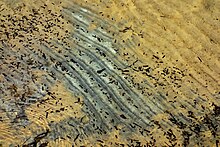Sand wave


A sand wave is a lower regime sedimentary structure that forms across from tidal currents.[1]
Formation
Sand waves are formed through the action of the wind or water (through waves or tidal currents)[2] and are a product of unidirectional flow. Sand waves are the result of a mean flow velocity between 40 and 70 cm/s.
Sand waves also form underwater.[3][4]
See also
References
- ^ Allen, J.R.L. (1980). "Sand waves: A model of origin and internal structure". Sedimentary Geology. 26 (4): 281–328. Bibcode:1980SedG...26..281A. doi:10.1016/0037-0738(80)90022-6.
- ^ Olsson-Seffer, Pehr Hjalmar (1910). Genesis and Development of Sand Formations on Marine Coasts. Augustana Book Concern, Printers. p. 17.
Sand wave formed by winds.
- ^ Pilkey, Orrin H. (2011-02-19). The World's Beaches: A Global Guide to the Science of the Shoreline. University of California Press. ISBN 978-0-520-26871-5.
- ^ View toward San Francisco Bay of the massive sand wave field – via ResearchGate.
External links
![]() Media related to Sand waves at Wikimedia Commons
Media related to Sand waves at Wikimedia Commons
